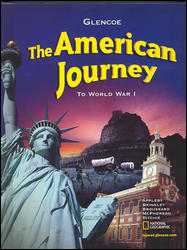The American Journey to World War IChapter 5:
The Federalist EraWeb Lesson PlansIntroduction
In this chapter students read about the early years of the United States. Although President George Washington warned of the dangers of political parties in his Farewell Address, it was too late. Many Americans had already chosen sides. The first political parties, the Federalists and the Democratic-Republicans, had already formed.
Lesson Description
Students will visit the ThinkQuest Library Web site's entries on American political parties. They will read about the first two parties in America and answer questions. Then they will create a flyer that could have been distributed to influence people to join either the Federalist or Democratic-Republican Party.
Instructional Objectives- The learner will be able to define the time periods for the Federalist and Democratic-Republican Parties.
- The learner will be able to name important leaders of the Federalist and Democratic-Republican Parties.
- The learner will be able to describe important events in the history of the Federalist and Democratic-Republican Parties.
- The learner will be able to organize information to create a flyer promoting one of the political parties.
Student Web Activity Answers- The Federalist Party began to form out of the controversy over the adoption of the proposed Constitution in 1787 and 1788. A well-defined Federalist Party did not exist, however, until 1794. After Washington's inauguration in 1789, debate arose in Congress and the cabinet over the proposals of Secretary of the Treasury Alexander Hamilton that the national government assume state debts, fund the national debt, and create a national bank. The opposition to Hamilton rallied around Secretary of State Thomas Jefferson and Congressman James Madison.
- Answers may include Alexander Hamilton, John Adams, John Jay, Fisher Ames, Roger Sherman, Jonathan Trumbull, Rufus King, and John Marshall.
- The party's beliefs included opposition to Hamilton's economic proposals, demands for the government to be responsible to popular majorities and operate with a narrow construction of the Constitution, and the denial of the national bank. The party emphasized states' rights as opposed to centralized government and supported personal and political liberties. In foreign policy, it favored France over Britain.
- Thomas Jefferson, James Madison, Albert Gallatin, James Monroe, John Taylor
- Students' flyers will vary.
 | 




